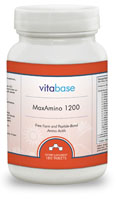Proline is a non-essential amino acid that is involved in the production of collagen and in wound healing. Proline is actually not an amino acid, but an imino acid. The primary amine on the α carbon of glutamate semialdehyde forms a Schiff base with the aldehyde which is then reduced, yielding proline. Unlike other amino acids which exist almost exclusively in the trans- form in polypeptides, proline can exist in the cis-configuration in peptides. When proline is in a peptide bond, it does not have a hydrogen on the α amino group, so it cannot donate a hydrogen bond to stabilize an α helix or a β sheet. Proline is unable to occupy many of the main chain conformations easily adopted by all other amino acids. Proline is unique in that it is the only amino acid where the side chain is connected to the protein backbone twice, forming a five-membered nitrogen-containing ring. Proline is a component of collagen, a major structural component of cells and animals. Collagen, which is the most abundant protein in the body, makes up much of the organic mass of skin, tendon, blood vessels, bone, cornea, vitreous humor of the eye, and basement membranes of all organs. Collagen is composed of the metabolic by-product of proline called hydroxyproline.
|
